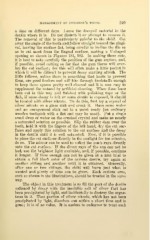Page 397 - My FlipBook
P. 397
MANAGEMENT OF CHILDREN 's TEETH. 249
a time on different days. Leave the decayed material in the
dentin where it is. Do not disturb it or attempt to remove it.
The removal of this is particularly painful to the child. Cut
away the angle of the tooth and follow straight toward the gingi-
val, leaving the surface flat, being careful to incline the file so
as to cut most from the lingual surface, making a V-shaped
opening as shown in Figures 181, 182. In making these cuts,
it is best to note carefully the position of the gum septum, and,
if possible, avoid cutting so far that the gum tissue will over-
lap the cut surface; for this will often make a little pocket in
which it will be difficult to prevent decay starting afresh. The
little fellows, unless there is something that hurts to prevent
them, are good feeders and will bite through foodstuffs enough
to keep these spaces pretty well cleaned and it is now easy to
supplement the natural by artificial cleaning. When these have
been cut in this way and finished with polishing tape or the
disk, if some decay is left or some dentin is exposed, it should
be treated with silver nitrate. To do this, first lay a crystal of
silver nitrate on a glass slab and crush it. Have some water
and an orangewood stick cut to a point ready (an ordinary
wooden toothpick with a flat end may be used). Put a single
small drop of water on the crushed crystal and make as nearly
a saturated solution as possible. Slip the rubber dam over the
teeth, hold it with the fingers of the left hand, dry the cut sur-
faces and apply this solution to the cut surface and the decay
in the dentin until it is well saturated. Now, if it is possible
to place the cut surfaces directly in the sunlight for ten minutes,
do so. The mirror can be used to reflect the sun's rays directly
onto the cut surface. If the direct rays of the sun can not be
had, use the brightest light available, and, if possible, continue
it longer. If time enough can not be given at a first trial to
obtain a full black color of the carious dentin, try again at
another sitting and another until it is obtained. Generally,
after one or two sittings, the child will learn just what is
wanted and plenty of time can be given. Each carious area,
such as shown in the illustrations, should be treated in the same
way.
The object in this treatment is to fill the part of the dentin
softened by decay with the insoluble salt of silver that has
been precipitated by light, and incidentally to destroy the organ-
isms in it. That portion of silver nitrate, which has not been
precipitated by light, dissolves out within a short time and is
it is of no value. It is useless to endeavor to treat such
gone ;


